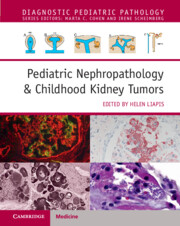Book contents
- Pediatric Nephropathology & Childhood Kidney Tumors
- Diagnostic Pediatric Pathology
- Pediatric Nephropathology & Childhood Kidney Tumors
- Copyright page
- Dedication
- Contents
- Contributors
- Preface
- Section 1 Normal and Abnormal Human Kidney Development
- Chapter 1 Normal Human Kidney Development and Congenital Anomalies of the Kidneys and Urinary Tract
- Chapter 2 Distribution of Pediatric Renal Biopsy Diagnoses in a Large Single Center and Rare Pediatric Cases
- Section 2 Glomerular Diseases
- Section 3 Tubulointerstitial Diseases
- Section 4 Vascular Diseases
- Section 5 Infectious Diseases
- Section 6 Cystic Diseases
- Section 7 Solid Tumors of the Kidney
- Section 8 Transplant Pathology of the Kidney
- Index
- References
Chapter 1 - Normal Human Kidney Development and Congenital Anomalies of the Kidneys and Urinary Tract
from Section 1 - Normal and Abnormal Human Kidney Development
Published online by Cambridge University Press: 10 August 2023
- Pediatric Nephropathology & Childhood Kidney Tumors
- Diagnostic Pediatric Pathology
- Pediatric Nephropathology & Childhood Kidney Tumors
- Copyright page
- Dedication
- Contents
- Contributors
- Preface
- Section 1 Normal and Abnormal Human Kidney Development
- Chapter 1 Normal Human Kidney Development and Congenital Anomalies of the Kidneys and Urinary Tract
- Chapter 2 Distribution of Pediatric Renal Biopsy Diagnoses in a Large Single Center and Rare Pediatric Cases
- Section 2 Glomerular Diseases
- Section 3 Tubulointerstitial Diseases
- Section 4 Vascular Diseases
- Section 5 Infectious Diseases
- Section 6 Cystic Diseases
- Section 7 Solid Tumors of the Kidney
- Section 8 Transplant Pathology of the Kidney
- Index
- References
Summary
We present the sequence of events leading to the permanent human kidney. Nephrogenesis begins around 22 days after fertilisation and completes around the 34–36th week of gestation. There are three pairs of kidneys in human development: the pronephros, mesonephros and metanephros, arising sequentially from intermediate mesoderm on the dorsal body wall. The first two pairs involute and are resorbed during fetal life, but they are essential precursors to the metanephros and normal adult kidneys do not develop if they are disrupted. Human metanephric kidney development begins around day 28 post conception when the ureteric bud arises as an outpouching of the distal mesonephric duct/Wolffian duct. Glomeruli form from 8–9 weeks and nephrogenesis continues in the outer rim of the cortex until 34 weeks. Perturbation of early pathways can lead to a range of phenotypes including renal agenesis, dysplasia and duplex kidneys, as well as malpositioning defects such as pelvic or horseshoe kidneys if they fail to ascend to their normal 12th thoracic to 3rd lumbar vertebral site during development.
- Type
- Chapter
- Information
- Pediatric Nephropathology & Childhood Kidney Tumors , pp. 1 - 16Publisher: Cambridge University PressPrint publication year: 2023



